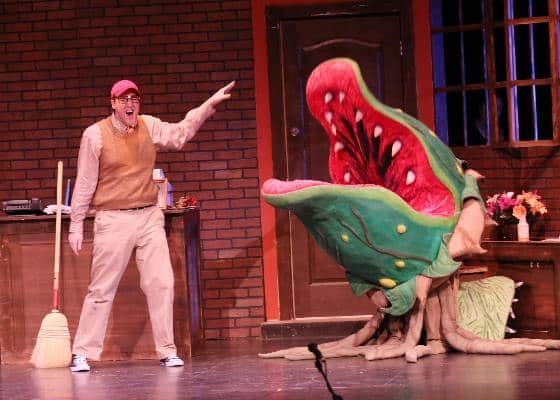
Have you ever considered doing “pit work”?
“Pit work… what’s that?” you ask. Chances are you’ve already seen it in action but maybe you just didn’t know what to call it.
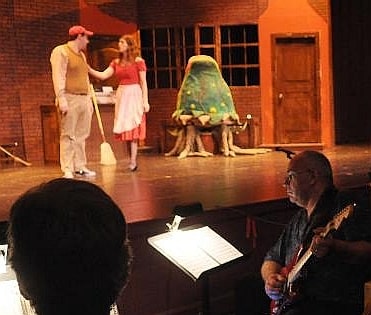 Playing in the “pit” is the name given to playing for Broadway style shows (e.g., musical theatre productions). It can very similar to playing with a “house band” for other types of live performance shows like you might see at a show at Disney World, in Vegas or Branson, MO.
Playing in the “pit” is the name given to playing for Broadway style shows (e.g., musical theatre productions). It can very similar to playing with a “house band” for other types of live performance shows like you might see at a show at Disney World, in Vegas or Branson, MO.
The “pit” name comes from the traditional location of the orchestra (usually located in a lowered area in front of the stage called the orchestra pit) in which musicians perform for forms of theatre that require music (such as Opera and Ballet).
Granted, most opera (unless your doing something like the Who’s “Tommy”) probably isn’t going to have many guitar parts to play. But modern shows like “Little Shop of Horrors”, Broadway’s new “Spider-Man (with music by Bono and the Edge from U2), or “Rock of Ages” (a movie version comes out Summer 2012), are chocked full of tasty guitar parts!
But I live in Iowa or Alaska… NOT in New York, Chicago (or any other place you may think of as having a large Arts community doing these kinds of productions).
Does your local high school ever put on a senior class play? Does your hometown have a local community theatre doing summer runs with volunteer actors? Maybe your church puts on a Christmas musical. Chances are there are opportunities to play music within your own town that you just never thought about before. It’s time to think “outside the box” (and get “in the pit”).
My first experience with this type of work actually came about through a connection from my playing with my church’s praise band on Sunday mornings. Our worship minister had gotten involved in a side project as the musical director for a local community theatre production of “Joseph and the Amazing Technicolor Dreamcoat” and ended up calling me looking for guitar player.
But I can’t read music. I only play rock (or country, or blues, or whatever)…
We’ve already said you’re looking for a chance to play and have fun so let’s keep thinking outside the box… These types of shows can be a great way to expand your musical skills. And if you’re working as a volunteer, expectations can be a lot less than if you were a hired pro expected to play every note perfectly by sight. Sure reading music is important… but having a good ear can be just as important. And maybe this will be just the type of gig you need to finally learn how to read!
So how do you start?
When I got the call for Joseph I had been playing regularly at church for a few years so I was somewhat familiar with basic chord charts but I’ll admit that I’ve forgotten much of that music theory class I had back in college some 20+ years ago. So the idea of somebody handing me a score full of printed sheet music was pretty scary at first.
The first thing I did was go online to a few of the guitar forums I belong to and asked the other members for advice. Forums and sites like this one can be a goldmine of information – you just have to ask!
One of the best bits of advice somebody gave me was, “Do yourself a favor and get a Broadway cast recording of the show. You can usually find them cheap on eBay. It’ll make it a lot easier to learn if you get a feel for the entire song. When all you have is the guitar part, it’s tough to get a good feel for the tune.” I’ve now done four of these kinds of shows and have always followed that tip.
Other tips I was given include:
- • “…take a small amp, a couple good OD pedals, a volume pedal, and a delay. Learn your part, and be prepared to be uber flexible. Theater performances and actors are way different than normal musicians.”
• “A good tone at a low volume… knowing your cues, having good timing…”
• “Feel is much more important than trying to play the score exactly as written. Chances are, when you get there, they’ll have a million cuts to make anyway to each number.”
• “…have a muting tuner in case someone bumps into you or you hit something. You might have to retune on a dime.”
• “Turn off your cell phone.”
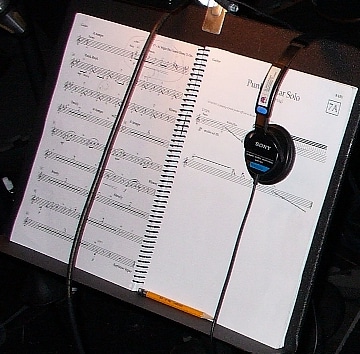 So I got my copy of the music and spent the next two weeks practicing each night with the soundtrack I downloaded from iTunes. We ended up having three rehearsals with the full band (music director on piano, bass, drums, two horn players and me on guitar).
So I got my copy of the music and spent the next two weeks practicing each night with the soundtrack I downloaded from iTunes. We ended up having three rehearsals with the full band (music director on piano, bass, drums, two horn players and me on guitar).
The first night was spent just working on individual songs with the actors and singers. The next night was a complete run through of the show with a few stops along the way to work on key parts and cues.
These cues may be musical or they may be based on specific lines by the actors so listening is critical at all times. This kind of work is different than a typical bar gig where keeping things loose and casual can be a good thing. Here you’ll want to stay focused and ready to hit that first note as soon as the actor delivers their key line. Do it right and it makes the show magical. Do it wrong and you may suddenly feel very exposed!
The third night was a full dress rehearsal from top to bottom without stops. After each practice the music director would go over specific cues with the band and director. Sometimes these caused changes to be made to the songs/show (e.g., cut out a repeat here, add an extra turn-around there while the stage hands reset the stage, etc.).
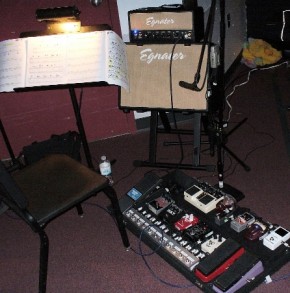 Joseph ran over two weekends with shows on Friday and Saturday nights and one on Sunday afternoon. Larger productions may do two shows on Saturdays. However, in general these types of gigs usually involve 4-8 shows over the course of a few days during a week or two run. Things like a church Christmas musical may have fewer performances.
Joseph ran over two weekends with shows on Friday and Saturday nights and one on Sunday afternoon. Larger productions may do two shows on Saturdays. However, in general these types of gigs usually involve 4-8 shows over the course of a few days during a week or two run. Things like a church Christmas musical may have fewer performances.
Since doing this first show back in 2009 I’ve played three others: The local high school’s production of “The Wizard of Oz”, and community theatre productions of “The Little Shop of Horrors” and “Baby: The Musical” at the local performing arts center. Each show has been different but they have also had a lot in common. And with each one I’ve improved my musical skills (playing and reading) and refined my rig along the way. I’m a better player today based on what I’ve learned from each show.
I want to play but I also want to make some money!
A lot of factors go into these shows when it comes to getting paid. Something like a high school or church musical may not have the budget to pay the musicians, actors, etc. Since these kinds of productions have to rely on volunteers they may be the perfect way to get started. Often they are just happy to have you so the pressure will be off if you’re a little nervous starting out.
Other shows, like many community theatres, use volunteer actors but will pay the musicians. Around here, this pay can range from about $40-75 per night for the band (albeit the musical director gets more). And you can often score some complimentary (or discounted) tickets so your family and friends can come to the show. How you calculate the pay depends on if you count the practices or just the show nights when doing the math.
For example, if a show has 4 performances and 3 rehearsals then you may get $300 flat rate plus some type of discount on tickets. You could say you made $75/night for 4 shows or you may say it was a total of 7 nights of your time, which comes to $43/night when you divide 7 into $300.
Bigger productions may follow the more traditional pay scales used by the musicians union (like they do on Broadway), which can include a base salary and more. But for those of us living somewhere in Small-town, USA this probably won’t be the case.
So what other tips do you have for getting started?
- • Get that soundtrack CD or at least go to
- and get yourself familiar with the music. These kinds of shows will often include bits and pieces from a wide range of musical styles (rock, country, Dixieland, western, Show tunes, etc.) so be prepared to expand your musical vocabulary.
• Make a copy of the printed sheet music (the “chart” or “score”) if possible so you can write lots of notes in it. Otherwise, write your notes lightly in pencil since you’ll probably have to erase them when you return the chart. Pay close attention to things like repeat signs and endings since many numbers may only include a verse and chorus and not the whole song you heard on the CD recording.
• Make notes on the page BEFORE regarding gear changes (e.g., switching off your fuzz before you’re two measures into the next song – a soft and romantic ballad!)
• Try to have the dialogue (actor’s lines) BEFORE each cue in the score (you’ll probably need to write it in yourself) and try to get as familiar with their lines as possible. That way, if an actor skips a line, you still know where it should have been and can better follow the leader for the next cue (Yes, actors make mistakes – your job is to adapt – the show must go on).
• Before each tune glance at the guy next to you – are you on the right tune? Better to double-check than dive into the next song only to find out you skipped a song when you flipped the page!
• Plan to layout a little early (if possible) when making major changes (e.g., switching guitars) between songs. You’ll appreciate the extra time as it goes by FAST (especially if an actor skips a line and a cue comes early!)
• Don’t be afraid to write in even the simple stuff (especially if you’re not good at reading music). Write in “Key = E” if you can’t remember if it’s 3 or 4 sharps in the key signature.
• Keep it simple – many composers don’t know the guitar that well and will over-write chord symbols, etc. (e.g., the chart says to go from C7 to C6 to C7b5 all in one measure but just sticking to the basic C or C7 chord may actually work better).
• Trust your ears – playing with more musicians is different than playing solo or with a small combo. If you think of the overall sound as a canvas or quilt then your piece of the overall picture will be a lot smaller since you have to share the landscape with more instruments and parts. Try things like playing a 2-3 string version of a chord rather than a full barre-chord. Learn to share the music/sonic road and you’ll be a better player overall.
• Know your part but also know when it may be OK to go “off the score.” However, once you work out your part, be consistent with it since the actors and/or other band members may be listening for a certain musical cue from you (e.g., in the Joseph song “One More Angel in Heaven” a few extra country licks can really enhance the overall song, but the trumpet part has a cue where it picks up the melody from the guitar so make sure what you’re playing fits and sets up the next part).
• If you get lost, take a breath and get your bearings before jumping back in – “When in doubt, lay out” (i.e., unless you’re the featured instrument nobody will probably notice if you don’t play for a measure or two, but they WILL notice if you play the wrong thing at the wrong time!)
• When in doubt, follow the piano… they’re probably the most important of all the instruments (at least for most shows) and everything else is just icing on the cake. The actors have probably been practicing with the piano from day one so let it lead (many musical directors lead the show from the keys).
• Space is usually limited in the pit – only bring what you need (maybe just a couple pedals instead of your full board). Usually a small combo amp, 3-4 pedals and 1-2 guitars will be all you really need (and probably all that you can fit).
• If you can make a copy of the score then tape the pages together so that each song becomes a single (wide) sheet of paper. Many songs may be 3-5 pages long, which will fit nicely across 2 music stands if there is room. Try to keep your hands on your guitar for the entire song and just flip between songs! Taping the pages together can also prevent dropping a page and getting them out of order.
• Make sure your view of the conductor is right above your music stand – peripheral vision is key for not missing a cue, etc.
• Get your own monitor mix if possible and point it right at your ears. Remember that listening is critical.
• Make sure you gear is in top working order (fresh strings, new batteries, good cables, etc.) and that you have spares of everything (tubes, amp fuse, strings, power supply, picks, etc.).
• Show up early enough to check your setup before the schedule “call time.” The show must go on and it will not wait on you.
• Be sure you can get the sound/tone you want at LOW volume levels. Actors may not always be on mics and it is them the audience is there to see so you have to play at a level that supports them but doesn’t overpower them. And have your volume settings balanced between your pedals – the sound guy has more important things to focus on (e.g., actors’ mics) than keeping your guitar levels in check.
• Always run a quick sound check with the entire band (and some singers if possible) to make sure you can hear yourself in the monitor – once the show starts it’s too late to be messing with monitor levels. This can be extra critical depending on your exact location for the show… I’ve played in the pit in front of the stage and I’ve played on the stage hidden behind the curtain with no view of the actors at all. Good hearing was the only way I made it through those shows!
• Put a volume pedal at the END of your chain (after delay/reverb, etc.) so you can use it as a mute/kill switch in case of a major mistake! Nothing worse than hearing “mistake, mistake, mistake…” from your DD-20 (LOL)!
• Walk yourself through the motions of how you’ll be setup and make changes (switch guitars, etc.) so that you don’t draw attention to yourself (and away from the actors on stage) If you’ll be seen by the audience then make sure you ask about what to wear (usually black is best) before the show.
• Get a little clip-on light that you can put down at your feet as it may be pretty dark in the pit. Just make sure you’re the only one who sees the light.
• Be polite and helpful so that everyone remembers you as a great person to have in the next production. Making friends with the conductor/music director, the sound guy, actors and other musicians will go a long way to ensure a smooth show and a call back (or recommendation) for future shows.
• Have FUN – how you feel will come thru in how you play!
• Remember, it’s not all about you – this is a play and not a concert – you’re job is to accompany the actors on stage… making them look (‘er sound) good is what makes you look good.
And lastly, sometimes you just have to make it up as you go!
 One of my most enjoyable shows was the high school’s Wizard of Oz. Since this play comes from back in the 1930’s before guitars were common pit instruments there was no guitar part written (only piano, percussion and a few horn and flute parts). The bass player pretty much followed the piano’s left hand but what was I going to play on the guitar?!?!
One of my most enjoyable shows was the high school’s Wizard of Oz. Since this play comes from back in the 1930’s before guitars were common pit instruments there was no guitar part written (only piano, percussion and a few horn and flute parts). The bass player pretty much followed the piano’s left hand but what was I going to play on the guitar?!?!
I first went online and got the sheet music for the major songs in the show. These included “If I Only Had a Brain”, “Ding Dong, the Witch is Dead” and, of course, “Somewhere Over the Rainbow”. Now I just had to decide what I could play that would support the actors on stage and enhance the overall sound of the show.
I ended up going with a mix of rhythm guitar chords for some songs and single note melodies for others. The choice depended a lot on the strength of the singers leading each song.
For example, the ‘ding dong’ song was sung by a group of elementary school kids playing the Munchkins. I felt that providing them with a strong melody line would be the most helpful in keeping the song on target. Here’s a clip I recorded during one performance with my Zoom H2 on a stand next to my amp. The sound you hear is pretty much the same as I heard it in the pit with the other instruments around me. The kids were not on mics so their voices are only coming from them on stage.
SAMPLE: Ding Dong the Witch is Dead
For the “only had a brain / heart / nerve” songs I kept it simple and just played chords, letting the actors take the lead vocally.
SAMPLE: If I Only Had a Brain
 Over the Rainbow is such a classic melody (just ask Jeff Beck, Judy Garland, etc.) that I wanted to make sure I did nothing that would detract from this high point in the show. I ended up playing a very clean Strat melody line under the singer’s vocal. No extra fills, just play it straight.
Over the Rainbow is such a classic melody (just ask Jeff Beck, Judy Garland, etc.) that I wanted to make sure I did nothing that would detract from this high point in the show. I ended up playing a very clean Strat melody line under the singer’s vocal. No extra fills, just play it straight.
SAMPLE: Somewhere Over the Rainbow
A final tip is to record yourself and the band (I try to record every practice) since these recordings will be the exact arrangements, keys, etc. that you’ll be playing (vs. some soundtrack CD version that may or may not be exactly like your show). Use these recordings for both practice and to critique yourself afterwards so you know what to work on for the next show.
I’ll see you in the pit…
I hope this has given you some ideas for expanding your playing opportunities and maybe building your musical skills along the way. Pit work can be a lot of fun… and I can promise that it will always be interesting since no two shows are ever alike!
Oh, and don’t forget to turn off your cell phone!


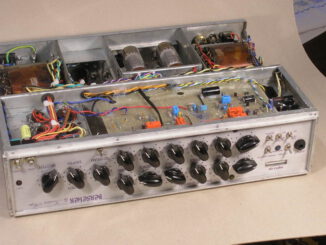

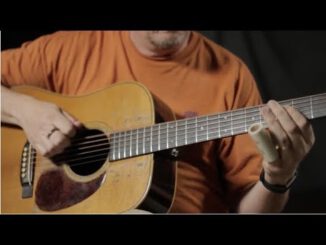
Be the first to comment